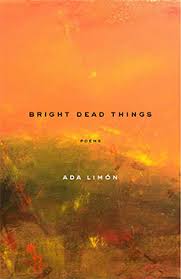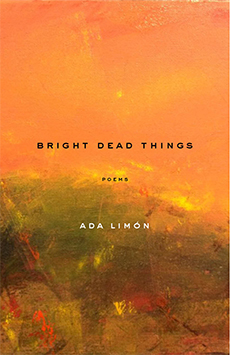What We’re Reading: Bright Dead Things

 Bright Dead Things by Ada Limón (Milkweed Editions, Sept 2015)
Bright Dead Things by Ada Limón (Milkweed Editions, Sept 2015)
Apparently today is National Poetry Day. While every day is poetry day for me, what better way to celebrate the nationally acknowledged day than with one of my absolute favorite poets: Ada Limón. I first fell in love with Ada Limón with her third collection of poems in 2010, Sharks in the Rivers (and reviewed it here). Those poems settled into my bones with a force, and I took on fan-girl status. Fan girl flames were flared when I heard of the publication of this new collection. Suffice to say, this Limón fan girl was not disappointed.
I’ve already read Bright Dead Things through at least four times, and it’s a collection that I know I’ll keep coming back to. Again, these poems settle into the body with a permanence. Limón’s voice in this collection carries some bitterness, dry humor, and a lot of bite. Soft moments are sprinkled in a little more rarely than the other moments, but enough to give us a resting place before Limón jerks us along to the next scene.
There are four sections in the book. Here is what I took from these sections: the first is fight and defiance and animalistic. Second chronicles a slow, inevitable death, a mother figure’s sickness and eventual passing. The third is about love, and the (sometimes reluctant) surprise of it. The fourth is a reconciliation of it all. Changing geography also plays a role throughout, with ghosts of New York and California haunting her on a move to rural Kentucky. A final theme I want to mention is the act of aging, and the reconciliation of past, current, and future selves.
The opening poem, “How to Triumph Like a Girl”, starts the book off with a, well, swagger, to use one of the words from the poem itself. An excerpt:
I like their lady horse swagger,
after winning. Ears up, girls, ears up!
But mainly, let’s be honest, I like
that they’re ladies. As if this big
dangerous animal is also a part of me,
that somewhere inside the delicate
skin of my body, there pumps
an 8-pound female horse heart,
giant with power, heavy with blood.
This heart is always present, always out there. I love the brave vulnerability of Limón’s writing; everything is out there for us to see, judge, and swallow along with her. She also manages to harness complexity of life and people and death, but also speak these complexities in a transparent tongue. Her language isn’t out to prove something; it’s out to explore, on an elemental level.
The second section is rife with anger and grief. The main subject is the speaker’s mother figure (I think her step-mother? It can be hard to keep track.), who becomes terminally ill, and the poet moves in to take care of her in her final days. This isn’t a sweet reflection on death. This is a painful, raw, anger-filled reflection on the ugliness of death. Yet, Limón knows how to deliver this pain in a way that we can absorb it; sandwiching the grief with moments of pause and dry humor. For example, the poem “The Quiet Machine” rolls us gracefully and smoothly through humor, contemplation, more humor, then, bam, fiery heartache:
I’m learning so many different ways to be quiet. […] There’s how I don’t answer the phone, and how I sometimes like to lie down on the floor in the kitchen and pretend I’m not home when people knock. […] There’s shower silent and bath silent and California silent and Kentucky silent and car silent and then there’s the silence that comes back, a million times bigger than me, sneaks into my bones and wails and wails and wails until I can’t be quiet anymore. That’s how this machine works.
“In the Country of Resurrection”, the last poem of this section, starts with a violent mercy killing of an already dying possum on the road. Yet, while the majority of the poem focuses on this death, the last few lines give us a little hope.
But that was last night. This morning
the sun is coming alive in the kitchen.You’ve gone to get us gas station coffee
and there is so much life all over the place.
It’s a small gesture, but a gesture nonetheless, to face a new day with a tentative hope, a way to move on from death.
Section 3 is about love, perhaps an unexpected love. The act of aging, and finding love almost surprises the poet, as she looks back at the shadow of her younger self, to her current self. She’s reconciling with both of those selves. While the poem “During the Impossible Age of Everyone” is from the first section, it captures the essence of love, and the new discomfort of it, in the closing lines:
3.
There is a slow tractor traffic hollering outside,
and I’d like not to be traffic, but the window shaking,
Your shoes are piled up with mine, and the heat
comes on, makes a simple noise, a dog-yawn.
People have done this before, but not us.
The final section, as I said, feels like a reconciliation of all the previous sections together in a new sense of being. This section opens up, take a higher, forward-looking perspective on life after this bloody transformation. The opening poem “Adaptation” says it all: “[…] Still, how the great middle / ticker marched on, and from all its four chambers / to all its forgiveness, unlocked the sternum’s / door, reversed and reshaped until it was a new / bright carnal species, more accustomed to grief, / and ecstatic at the sight of you.”
Limón says on this National Book Award page, that “When I was writing Bright Dead Things, I was constantly trying to push myself to say what was true—and sometimes unnerving—for me. […] I’d go for walks or drives and ask, “What are you scared of?” and when I found the answer, I’d find the poem.”
And also: “Finding a language for joy was intensely hard. It was easier to go into the pitch-black caves, to plummet into the colder, harder core of the self, than to risk admitting that there is pleasure in this life, that being alive in and of itself is an ecstatic thing.” It’s this vulnerability that pulled at my gut when reading these poems. She looks fear in the eye, and on the next page, she lets herself experience joy (even if it’s often tinged with sadness). In fact, it’s that juxtaposition, the closeness of dark and light, that makes the other more clear.
What other poets juxtapose light and dark, always on the edge of vulnerability?
What We’re Reading: Fall Book Preview
 The weather is hinting at autumn here in Minnesota…we’ve had a slew of cooler temperature days with fall-colored skies. While I’m still a little in denial about the end of summer, I’m not-so-secretly looking forward to my favorite season. Fall is the season where I cut back on my social butterfly schedule, and take deep joy in staying home in sweatpants with my cat and a book. Here are a few books I’m looking forward to reading this fall.
The weather is hinting at autumn here in Minnesota…we’ve had a slew of cooler temperature days with fall-colored skies. While I’m still a little in denial about the end of summer, I’m not-so-secretly looking forward to my favorite season. Fall is the season where I cut back on my social butterfly schedule, and take deep joy in staying home in sweatpants with my cat and a book. Here are a few books I’m looking forward to reading this fall.
 Bright Dead Things by Ada Limón (Milkweed Editions, September)
Bright Dead Things by Ada Limón (Milkweed Editions, September)
You’ll see a review soon of this gem. It’s one that I’ve already read multiple times since receiving the review copy. My love of Ada Limón is well documented (previous review here), and Bright Dead Things only makes me fall deeper in love with her writing. The poems examine the human heart through loss of a close loved one, moving from New York City to Kentucky, and love. It’s contemplative, proud, and heartaching, all wrapped up in Limón’s delectable command of language.
The Story of My Teeth by Valeria Luiselli (Coffee House Press, September)
There’s already a lot of buzz about this book; folks are saying Luiselli pulls you into the weird world of the main character, Highway, and his collection of famous teeth. Both Luiselli and Highway are master storytellers, creating a space that is unlike any other, and hard to shake once you’ve entered.
The Walls by Matthew Henriksen (Black Ocean, Fall 2015)
I enjoyed Henriksen’s Ordinary Sun collection (brief review here), and am looking forward to this upcoming collection. His poems teem with honesty and imagistic wonder, both of which I gravitate towards. I haven’t heard much about this collection at all, which makes me all the more curious to see what Henriksen comes up with.
 Cat is Art Spelled Wrong by Caroline Casey, Chris Fischbach, and Sarah Schultz (Coffee House Press, September)
Cat is Art Spelled Wrong by Caroline Casey, Chris Fischbach, and Sarah Schultz (Coffee House Press, September)
Speaking of cats, I went to the CatVidFest recently, a participant of this internet-age phenomena of YouTube, cat humor, and community. Coffee House Press is devoted to exploring our contemporary world, and this collection of essays from 14 different writers will get you thinking about our society and it’s identity.
What books are you eagerly anticipating this fall?





